Reviewed
April 2025
by Felix Bustelo |
|
| HISTORY |
|
|
The Tjeld-class was a class
of twenty fast patrol boats were designed and built for the Royal Norwegian
Navy in the late 1950s. Boats were also sold to the West German, United
States and Hellenic navies during the 1960s. The class was based on a prototype
fast patrol boat, the Nasty, developed by a private firm in close collaboration
with the Royal Norwegian Navy. Norwegian officers shared their experiences
with fast patrol boats during World War II.
The Norwegian Tjeld-class vessels were used as
motor torpedo boats (motortorpedobåt). They measured 80 ft 5 in long
(24.5 m), with a beam of 24 ft 7 in (7.5 m) and a draught of 6 ft 11 in
(2.1 m). They could reach a top speed of 45 knots and were armed with a
20mm Rheinmettal gun forward, a 40mm single Bofors aft and four 21 in (533
mm) torpedo tubes. The boats were built and commissioned in two groups.
The first group of twelve were launched between 1959 and 1960, and commissioned
in 1960-1962. A second group of eight vessels were launched 1962-63 and
commissioned 1963-66. The twenty boats remained in service until the late
1970s and eventually were all disposed of by 1995. One vessel, Skrei (P380),
was transferred to the Royal Norwegian Navy Museum for preservation as
a museum ship.
The United States Navy ordered 22 vessels, built
to the Norwegian design but with different armament. Known as the Nasty
class, they were to be utilized as fast patrol boats employed by special
forces for clandestine operations along the coast of North Vietnam. The
torpedo tubes were removed and the gun armament comprised of a single 40
mm Bofors, two 20 mm guns and a piggyback 81 mm mortar/0.50 machine gun.
After an initial order of two vessels in 1962 the USN ordered a further
14 in 1966 with an agreement for an additional six to be built under license
in the United States by John Trumpy & Sons of Annapolis. All vessels
saw action in the Vietnam War, with six being lost in action. However,
at the end of the conflict all were disposed of except for PTF 17, which
is preserved at the Buffalo and Erie County Naval & Military Park.
The Hellenic Navy ordered six vessels in 1965.
Referred to as the Tjeld or Improved Nasty type patrol boats, they were
identical to the Norwegian boats, but with two single 40mm Bofors, with
one replacing the 20mm gun. The Greek boats remained in service until the
1980s, before being placed in reserve. All were disposed of by 1995.
The West German Nasty class, also known as the
Hugin class, were two fast patrol boats built for the post-war West German
Navy and identical to the Norwegian vessels. They were purchased in the
1960s for evaluation purposes, however they were transferred to Turkey
in 1964. The two boats served the Turkish Navy until stricken in 1973. |
| Hellenic
Ship Tjeld/Nasty Class Patrol Boat |
|
|
Hellenic Ship
Model’s kit of the Tjeld/Nasty Class patrol boats provides all the parts
needed to build either a Norwegian, US or (of course) Hellenic Navy version.
The kit is comprised of a 3D printed hull and smaller parts, a base with
pedestals and a decal sheet. The contents come in a small but sturdy box,
with the hull, 3D printed parts and decals inside a zip-lock bags. Assembly
instructions are provided in the box as well as two small pieces of sandpaper.
|
|

|
| HULL |
|
| The 3D printed hull is very nicely
done and sits on a printing raft with numerous thin attachment points at
the end of the supports holding it to the raft. The hull is nicely detailed,
with small cowl and mushroom vents, mooring bitts and a large vent aft.
The open bridge also has nice details. The deck has blanks where the 3D
printed hatch covers are supposed to go. Underneath, and they are hard
to see through the printing supports, are the propeller shafts and struts.
In 1/350 scale, the hull would be approximately 2.75 inches and the kit
hull measures exactly that. The print lines are just about invisible and
whatever are there should easily disappear under a coat of paint. Here
and there, some thin “threads” appear along the deck and details that are
a product of 3D printing and are to be removed. |
 |
 |
 |
 |
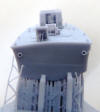 |
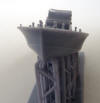 |
 |
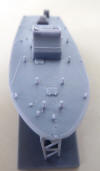 |
 |
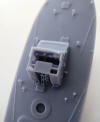 |
| SMALL
3D PRINTED PARTS |
|
|
A total of 10
print rafts with smaller parts are provided with the kit. All of the rafts
have thin attachment points that should make removing the parts fairly
easy but care must be taken with the more delicate items. Surprisingly,
none of the parts broke off during shipping considering how they were packed.
Most for the rafts contain the different weapons for the various fits.
There are a variety of single 40mm Bofors mounts, again depending on which
version you are planning to build. Some are fully printed and just need
to be removed from the raft, while some others require the gun to be attached
to the base and at least one of those appears to have a fully assembled
version included. The Bofors has the ring bases printed next to them when
applicable. Another raft has four 20mm Oerlikons, which appear to be well
done. There is also a raft with the four torpedo tubes, with the tips of
the torpedoes separate to attach as caps. A 3D printed torpedo is also
included if you wish to display the model firing out of the tube. This
is a very nice touch.
The remaining rafts provide various fittings and detail parts. These
include rudders and propellers, masts, jack and ensign staffs, two types
of radars, vents, hatches, storage baskets, ammo lockers, raft, anchor
with chain, life rings, life raft canisters oxygen tanks and what appear
to be floats (they look like tiny figs). One set of parts I did notice
are the stanchions for the safety railing. Again, what you use will depend
on which version of the vessel you will build.
As mentioned above, a nice base with two pedestals that are also 3D
printed are provided to display the full hull model if you so wish. |
 |
 |
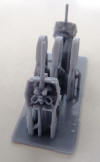 |
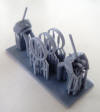 |
 |
 |
 |
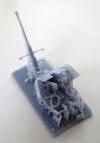 |
 |
 |
 |
 |
 |
 |
 |
 |
 |
 |
 |
 |
 |

|
| PHOTO-ETCH |
|
|
No
photoetch is provided with this kit and really none is needed.
|
| EXTRAS |
|
|
Two
small strips of sandpaper are included in the box. The grit of the sandpaper
is not written on the back of the strips but by touch, the darker strip
is a tad rougher than the other one which feels finer. These are an interesting
addition to a kit and while I don’t believe the print lines are so pronounced
of any of the parts that some sanding is needed, it is still a thoughtful
gesture.
|

|
| DECALS |
|
|
The decal sheet
provides a selection hull numbers for Norwegian, US and all six Greek boats.
The sheet also has Norwegian, US and Greek flags as well as Hellenic Naval
and NATO ensigns and a Jolly Roger. Yellow Greek alphabet ship names with
hull numbers are also on the sheet and I assume that they are meant to
be used as a nameplate on the base included with the kit.
|
 |
| INSTRUCTIONS |
|
|
The assembly
instructions come of two double-sided sheets and are ok but could provide
more detail in my opinion. The first page contains some specifications
for the boats used by the three navies that you can build with this kit.
There is also a brief history in Greek along with a color photo of one
of the ships in Hellenic naval service. The flip side has a list of the
Hellenic Navy vessels with hull numbers. Below is some more text in Greek
as well as a brief history in English. At the bottom of the page is the
first assembly diagram, showing the gun placement for the USN fit and where
the 20mm for the Norwegian boat goes. I did notice that for the some of
the guns, the images show that they need to be assembled with individual
parts while the 3D parts are one piece, which is a little confusing. Also,
the instructions show that Norwegian 20mm gun doesn’t have a shield, yet
all of the 20mm guns provided in the kit have shields. Is this an error
in the instructions or an omission in the kit parts? I guess you could
carefully remove the shield from one of the kit guns.
The third page has photos of a Greek, US and Norwegian boat which I
guess are supposed to help with assembly but they could be clearer. The
final page has two assembly diagrams showing the placement of most of the
remaining parts, but again somewhat confusing and could be more specific
as to what parts go with what version. No guidance on painting of decal
placement is provided. The modeler will need to search the Internet for
photos of Tjeld and Nasty class boats to help with your build. A good resource
is the PTF-Nasty website (https://ptfnasty.com/index.htm). While it focuses
on USN vessels fighting in Vietnam, it does have some information on the
boats in the other navies. |
|
|
|
| CONCLUSIONS |
|
| Overall, this is a good
kit and while I did point out some issues with the kit, these are relatively
minor and should not deter someone from purchasing this model. The hull
is really well done as are most of the smaller parts. With research you
will be to build a Tjeld/Nasty class patrol boats serving either the Norwegian,
United States or Hellenic Navy. I would recommend this kit to someone who
has experience working with 3D printed kits with some delicate parts. This
kit is only available directly from Hellenic Ship Models (https://www.hellenicshipmodel.gr),
and this subject is also available in 1:100, 1:144, 1:200 and 1:700 scales.
My thanks to Kostas Kokkinos for providing the review sample. |
